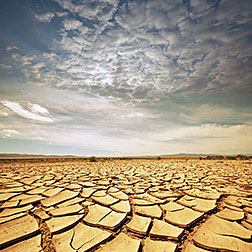- Number 400 |
- November 4, 2013
Water-stressed globe will face increased thirst, study finds

This study indicates the increasing
importance of water conservation
technologies and strategies, especially
in alrea.
By the end of the century, India and the Middle East – already dealing with water scarcity – will face more water stress as the rising demand for fresh water hits certain regions harder than others, according to new research at DOE’s Pacific Northwest National Laboratory. The team, working at the Joint Global Change Research Institute, a partnership between PNNL and the University of Maryland, used the Global Change Assessment Model (GCAM) to run projections of water demand and use through the end of the century.
The team assessed future water demands in the agricultural, energy, industrial and municipal sectors within GCAM. They assigned base-year water requirements to specific activities to maximize consistency between bottom-up estimates of water demand intensities of specific technologies and practices and top-down regional and sectoral estimates of water use. They represented these scenarios through 14 geopolitical regions with the agricultural sector further divided into as many as 18 agro-ecological zones within each region.
Considering three factors important for understanding future socioeconomic challenges to climate mitigation and adaptation:
- Population and demographic conditions,
- Socioeconomic development trajectory, measured by the United Nations, and
- Technology used in producing and consuming energy, agriculture and other goods and services,
the research established six future scenarios. Within these six storylines, the team identified two broad descriptors: either 1) progress develops ahead of or copes with rising populations or 2) the proportion and number of the extremely poor people increases. For each geopolitical region, the team explored the implications of the storylines. The study shows that water availability will increasingly be stressed as the climate changes, especially in already-dry regions. The Integrated Assessment Research Program in DOE's Office of Science funded the research. The program also provided support for the Evergreen computing resources located at the Joint Global Change Research Institute.
[Kristin Manke, 509.372.6011,
kristin.manke@pnnl.gov]
